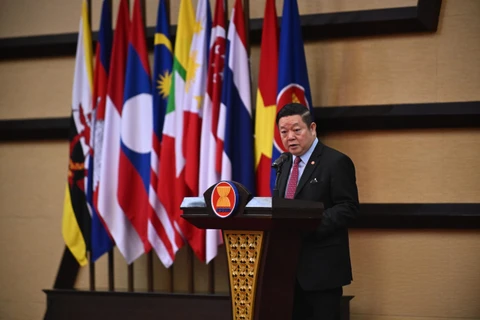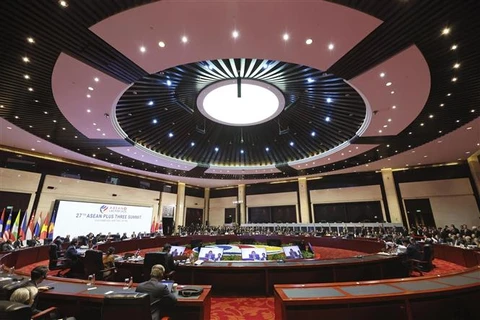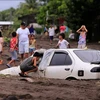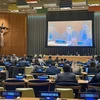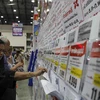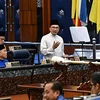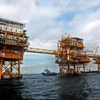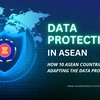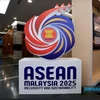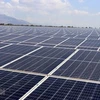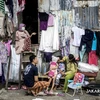
Hanoi (VNA) – “As we reflect on the outcomes of the 44th and 45th ASEAN Summits, it is evident that ASEAN is committed to building a future that is connected, resilient, and inclusive,” said Dr. Kao Kim Hourn, Secretary-General of ASEAN.
Following is the full text of an Op-Ed by Dr. Kao Kim Hourn, Secretary-General of ASEAN.
Navigating a Changing World: Insights from the 44th and 45th ASEAN Summit
Dr. Kao Kim Hourn
Secretary-General of ASEAN
The recently concluded 44th and 45th ASEAN Summits showcased ASEAN’s strong commitment to collaboration and strategic action amidst global challenges. Under Lao PDR’s chairmanship, with the theme ‘ASEAN: Enhancing Connectivity and Resilience’, Leaders from the ten ASEAN Member States gathered to confront pressing regional issues, shaping a collective vision for a more united, prosperous, and sustainable Southeast Asia. ASEAN likewise had Summits with its partners. These Summits are a testament to the importance of dialogue and diplomacy, and are an integral part of ASEAN’s journey towards deeper integration, enabling a unified regional response to global shifts.
High on agenda of the Summits was the progress made on the work in crafting the ASEAN Community Vision 2045 and its Strategic Plans, which will guide the region for years to come. As ASEAN approaches the completion of the Community Vision 2025, it has commenced charting its future direction for the next two decades, emphasising resilience, connectivity, inclusivity, and sustainability in response to emerging geopolitical and geoeconomic challenges and strategic opportunities. It is in this context that the Leaders adopted the ASEAN Leaders’ Declaration on the Development of Strategic Plans to Implement the ASEAN Community Vision 2045.
ASEAN Centrality stood at the heart of the Summits’ outcomes. Through the ASEAN Leaders’ Declaration on the ASEAN Outlook on the Indo-Pacific for the Future Ready ASEAN and ASEAN-Centred Regional Architecture, Leaders reaffirmed ASEAN’s role as the driving force in shaping the regional architecture. They stressed the need for unity in navigating shifting geopolitical and economic landscapes. In engagements with ASEAN’s partners, Leaders underscored the importance of multilateralism, international law, and advocated for dialogue, diplomacy and strategic trust to address global challenges, including developments in the South China Sea, the Korean Peninsula, Ukraine, and the Middle East, advocating for peaceful resolution.
On Myanmar, they deeply explored how best to move forward along a Myanmar-owned and Myanmar-led process in dealing with the situation, emphasising that Myanmar remains a member of the ASEAN family. Myanmar’s sending of a non-political representative to the Summit is seen as an indication of Myanmar complying with the Five Point Consensus (FPC), ASEAN’s main reference in addressing the political situation in Myanmar. The FPC has not yet reached its full potential, and should remain as the guiding framework for ASEAN’s engagement with Myanmar. In this regard, the Leaders adopted the third iteration of the ASEAN Leader’s Review and Decision on the Implementation of the FPC.
Leaders, likewise, praised the ASEAN Coordinating Centre for Humanitarian Assistance for its progress in delivering aid to Myanmar, including successful completion of Phase 1 (Life-Saving/COVID-19 response) and ongoing Phase 2 (Life-Sustaining) support. They acknowledged contributions from Thailand and other ASEAN Member States, external partners, and the private sector, and called for safe, transparent, and non-discriminatory aid delivery, reinforcing Point 4 of the FPC.
Economic integration and connectivity were also paramount on the agenda. Leaders recognised that deepening integration is crucial for ASEAN’s global competitiveness. Alongside the implementation of the Regional Comprehensive Economic Partnership (RCEP), the world’s largest FTA, the Summits also saw the substantial conclusion of the ASEAN-China FTA upgrade negotiation, whilst the ongoing modernisation of the ASEAN Trade in Goods Agreement (ATIGA), the FTA negotiations with Canada, and the review of our FTA with India are instrumental in fortifying the region’s trade network and supply chain resilience. The adoption of the Declaration on Supply Chain Efficiency and Resilience reinforces these efforts, strengthening regional connectivity, accelerating recovery, and fostering sustainable growth.
Digitalisation and sustainability were other central themes shaping the Summits’ agenda. ASEAN is advancing its digital transformation with initiatives like the ASEAN Digital Master Plan 2025 and the current negotiations for the ASEAN Digital Economy Framework Agreement, which could double the region’s digital economy to USD 2 trillion by 2030. Sustainability was equally prioritised, as Leaders reinforced the need for growth aligned with environmental stewardship. Highlighting progress on initiatives such as the ASEAN Strategy for Carbon Neutrality and the ASEAN Blue Economy frameworks, Leaders also adopted joint statements on climate change, biodiversity, and plastic circularity, solidifying ASEAN’s dedication to global environmental goals.
The Summits also highlighted critical areas for enhancing resilience in the region, such as health architecture, labour migration, and the protection of women and children. Leaders adopted declarations to strengthen biosafety and biosecurity and coordination during public health emergencies. Other important declarations adopted focused on advancing the care economy, preventing child labour – including elimination of its worst forms – and enhancing the skills, mobility, and protection of migrant workers.
ASEAN Leaders recognised the pivotal role of Southeast Asia’s 213 million youths in shaping the region’s future, calling for their voices to be integrated into the ASEAN Community Vision 2045 and Strategic Plans. They encouraged youth-driven solutions and innovation in areas such as AI, digital connectivity, fintech, climate change, and cross-cultural dialogues, recognising their potential to spur economic growth and sustainable development. Facing socio-economic challenges, including ageing populations and urban-rural disparities, Leaders emphasised the need to deepen people-to-people ties, to be reinforced by the soon to be concluded regional air services agreements, reskill and upskill the workforce, and empower youth, women, and creative industries. This approach will equip ASEAN in tackling future shifts whilst enhancing regional resilience and connectivity.
Solidarity amongst the Southeast Asian countries is the principle that underpins the eventual membership of Timor-Leste in ASEAN. Significant progress has been made in 2024, underscoring Timor-Leste’s dedication to adhere to the Roadmap for Full Membership. Some milestones include the appointment of Timor-Leste’s Ambassador to ASEAN and the opening of its mission in Jakarta, and voluntary contributions it made to ASEAN disaster relief efforts and the establishment of a dedicated Timor-Leste Unit at the ASEAN Secretariat. Additionally, Timor-Leste’s inclusion in the Initiative for ASEAN Integration (IAI) provides crucial support for capacity-building efforts, facilitating the nation’s deeper integration into ASEAN’s economic, political, and social spheres.
As we reflect on the outcomes of the 44th and 45th ASEAN Summits, it is evident that ASEAN is committed to building a future that is connected, resilient, and inclusive. The region is actively crafting a long-term vision, driving digital transformation, and advancing sustainability initiatives to tackle future challenges and seize emerging opportunities. The Summits reaffirmed ASEAN Centrality in the Indo-Pacific, underscoring the region’s strategic significance in global affairs. As ASEAN evolves, its ability to adapt and embrace new opportunities will be crucial in ensuring a united, resilient, and prosperous future for its people./.
